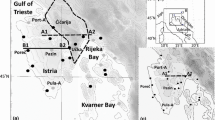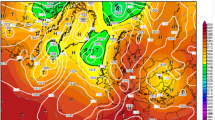Abstract
A sea-breeze event in south-west Western Australia is simulated using the Regional Atmospheric Modelling System (RAMS) version 6.0. The model is evaluated against high resolution soundings as well as station observations and is shown to reproduce the qualitative features of the sea breeze well. Sensitivity tests are carried out to investigate the effects of historical land-cover change and changes in soil moisture on the dynamics of the sea breeze. It is found that land-cover change alone, i.e., a change from wooded grasslands to bare soil, with no change in soil moisture initialisation, does not significantly alter the overall structure of the sea breeze but results in higher surface winds due to the reduced vegetation roughness length, which leads to enhanced surface moisture advection inland. On the other hand, land-cover change in conjunction with increased soil moisture results in a considerably weaker, shallower, and less penetrative sea breeze, and delays its onset and duration. A sea-breeze scaling analysis highlights the impact of increasing soil moisture on reducing the sea-breeze volume flux scale.
Similar content being viewed by others
References
Abbs DJ, Physick WL (1992) Sea-breeze observations and modelling: a review. Aust Meterol Mag 41: 7–19
Australian Surveying and Land Information Group (AUSLIG) (1990) Atlas of Australian resources: vegetation. Commonwealth of Australia, Canberra, ACT, 64 pp
Buckley RL, Kurzeja RJ (1997) An observational and numerical study of the nocuturnal sea breeze. Part I: structure and circulation. J Appl Meteorol 36: 1577–1598
Cai XM, Steyn DG (2000) Modelling study of sea breezes in a complex coastal environment. Atmos Environ 34: 2873–2885
Chen C, Cotton WR (1983) A one-dimensional simulation of the stratocumulus-capped mixed layer. Boundary-Layer Meteorol 25: 289–321
Chen C, Cotton WR (1987) The physics of the marine strato-cumulus-capped mixed layer. J Atmos Sci 44: 2951–2977
Clarke RH (1955) Some observations and comments on the seabreeze. Aust Meterol Mag 11: 47–68
Clarke RH (1989) Sea-breezes and waves: the Kalgoorlie sea-breeze and the Goondiwindi breeze. Aust Meterol Mag 37: 99–107
Cotton WR, Pielke RA, Walko RL, Liston GE, Tremback CJ, Jiang H, McAnelly RL, Harrington JY, Nicholls ME, Carrio GG, McFadden JP (2003) RAMS 2001: current status and future directions. Meteorol Atmos Phys 82: 5–29
Esau IN, Lyons TJ (2002) Effect of sharp vegetation boundary on the convective atmospheric boundary layer. Agric For Meteorol 114: 3–13
Garratt JR, Pielke RA, Miller WF, Lee TJ (1990) Mesoscale model response to random surface-based purturbations—a sea-breeze experiment. Boundary-Layer Meteorol 52: 313–334
Gentilli J (1971) Australian climate patterns. Thomas Nelson (Australia) Limited, Melbourne, 285 pp
Gero AF, Pitman AJ (2006) The impact of land cover change on a simulated storm event in the Sydney basin. J Appl Meteorol Clim 45: 283–300
Huang X, Lyons TJ, Smith RCG (1995) Meteorological impact of replacing native prerennial vegetation with annual agricultural species. Hydrol Process 9: 645–654
Hurley P, Manins P (1995) Meteorological modelling in high-ozone days in Perth, Western Australia. J Appl Meteorol 34: 1643–1652
Hutchinson MF, Stein JA, Stein JL (2009) GEODATA 9 Second Digital Elevation Model (DEM-9S) version 3. http://www.ga.gov.au/
Kain JS, Fritsch JM (1993) Covective parameterisation for mesoscale models: The Kain-Fritsch scheme. In: Emannuel A, Raymond DJ (eds) The representation of cumulus convection in numerical models. Am Meteorological Society, Boston, pp 165–170
Kala J, Lyons TJ, Foster IJ, Nair US (2009) Validation of a simple steady-state forecast of minimum nocturnal temperatures. J Appl Meterol Clim 48: 624–633
Kalnay E, Kanamitsu M, Kistler R, Collins W, Deaven D, Gandin L, Iredell M, Saha S, White G, Woollen J, Zhu Y, Chelliah M, Ebisuzaki W, Higgins W, Janowiak J, Mo KC, Ropelewski C, Wang J, Leetmaa A, Reynolds R, Jenne R, Joseph D (1996) The NCEP/NCAR 40-year reanalysis project. Bull Am Meteorol Soc 77: 437–471
Kruit RJW, Holtslag AAM, Tijm ABC (2004) Scaling of the sea-breeze strength with observations in the Netherlands. Boundary-Layer Meteorol 112: 369–380
Li F, Lyons TJ (2002) Remote estimation of regional evapotranspiration. Environ Model Softw 17: 61–75
Lyons TJ (2002) Clouds prefer native vegetation. Meteorol Atmos Phys 80: 131–140
Lyons TJ, Bell MJ (1990) Mesoscale variations in available wind power potential. Solar Energy 45: 149–166
Lyons TJ, Schwerdtfeger P, Hacker JM, Foster IJ, Smith RCG, Huang X (1993) Land-atmosphere interaction in a semiarid region: the bunny fence experiment. Bull Am Meteorol Soc 16: 551–558
Lyons TJ, Smith RCG, Huang X (1996) The impact of clearing for agriculture on the surface energy budget. Int J Clim 16: 551–558
Ma Y, Lyons TJ (2000) Numerical simulation of a sea-breeze under dominant synoptic conditions at Perth. Meteorol Atmos Phys 73: 89–103
Ma Y, Lyons TJ, Blockley JA (2001) Surface influences on the Australian west coast trough. Meteorol Atmos Phys 68: 207–217
Manins PC, Hurley PJ, Johnson GM, Azzi M (1992) Predicted windfields on possible ozone days. A contribution to Perth Airshed Photochemical Study funded by SECWA, CSIRO Division of Atmospheric Research, January 1992, 25 pp
Mellor GL, Yamada T (1982) Development of a turbulence closure model for geophysical fluid dynamics problems. Rev Geophys Space Phys 20: 851–875
Miao JF, Kroon LJM, de Arellano JVG, Holtslag AAM (2003) Impacts of topography and land degradation on the sea breeze over eastern Spain. Meteorol Atmos Phys 84: 157–170
Narisma GT, Pitman AJ (2003) The impact of 200 years of land cover change on the Australian near-surface climate. J Hydrometeorol 4: 424–436
Physick WL (1980) Numerical experiments on the inland penetration of the sea breeze. Q J Roy Meteorol Soc 106: 735–746
Pielke RA (2001) Influence of the spatial distribution of vegetation and soils on the prediction of cumulus convective rainfall. Rev Geophys 39: 151–177
Pielke RA, Cotton WR, Walko RL, Tremback CJ, Lyons WA, Grasso LD, Nicholls ME, Moran MD, Wesley DA, Lee TJ, Copeland JH (1992) A comprehensive meteorological modelling system-RAMS. Meteorol Atmos Phys 49: 69–91
Porson A, Steyn DG, Schayes G (2007) Sea-breeze scaling from numerical simulations. Part I: Pure sea breezes. Boundary-Layer Meteorol 122: 17–29
Ray DK, Nair US, Welch RM, Han Q, Zeng J, Su W, Kikuchi T, Lyons TJ (2003) Effects of land use in southwest Australia: 1. Observations of cumulus cloudiness and energy fluxes. J Geophys Res 108(D14): 4414
Reynolds RW, Rayner NA, Smith TM, Stokes DC, Wang W (2002) An improved in situ and satellite SST analysis for climate. J Clim 15: 1609–1625
Segal M, Avissar R, McCumber MC, Pielke RA (1988) Evaluation of vegetation effects on the generation and modification of mesoscale circulations. J Atmos Sci 45: 2268–2292
Steyn DG (1998) Scaling the vertical structure of sea breezes. Boundary-Layer Meteorol 86: 505–524
Steyn DG (2002) Scaling the vertical structure of sea breezes revisited. Boundary-Layer Meteorol 107: 177–188
Tijm ABC, Holtslag AAM, Delden AJV (1999) Observations and modeling of the sea breeze with the return current. Mon Weather Rev 127: 625–640
Walko RL, Band LE, Baron J, Kittel TGF, Lammers R, Lee TJ, Ojima D, Pielke RA, Taylor C, Tague C, Tremback CJ, Vidale PL (2000) Coupled atmosphere-biosphere-hydrology models for environmental modeling. J Appl Meteorol 39: 931–944
Xian Z, Pielke RA (1991) The effects of width of landmasses on the devlopment of sea breezes. J Appl Meteorol 30: 1280–1304
Yan H, Anthes RA (1988) The effect of variations in surface moisture on mesoscale circulations. Mon Weather Rev 116: 192–208
Zhong S, Fast F (2003) An evaluation of the MM5, RAMS, and Meso-Eta models at subkilometer resultion using VTMX field campaign data in the salt lake valley. Mon Weather Rev 131: 1301–1322
Author information
Authors and Affiliations
Corresponding author
Rights and permissions
About this article
Cite this article
Kala, J., Lyons, T.J., Abbs, D.J. et al. Numerical Simulations of the Impacts of Land-Cover Change on a Southern Sea Breeze in South-West Western Australia. Boundary-Layer Meteorol 135, 485–503 (2010). https://doi.org/10.1007/s10546-010-9486-z
Received:
Accepted:
Published:
Issue Date:
DOI: https://doi.org/10.1007/s10546-010-9486-z




